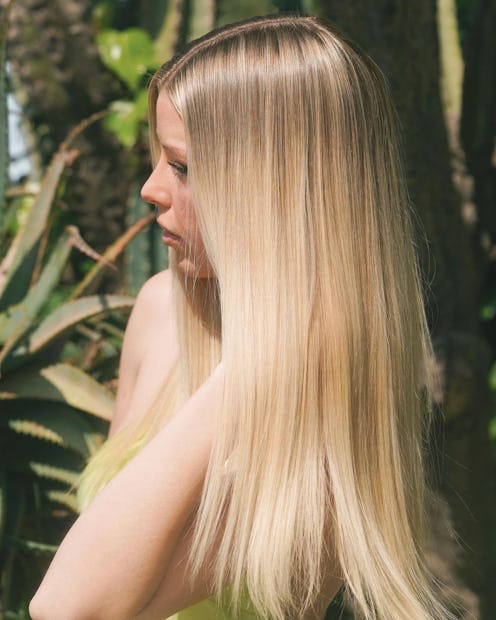(Hair)
At-Home Keratin Treatments Are All Over TikTok — But Are They Safe?
Stylists share their thoughts.

More often than not, stick-straight hair does not just happen. A widely favored solution if you don’t want to use hot tools daily: keratin treatments. Even celebs like Kim Kardashian have been know to get them. The popular salon service is by no means new and you’re probably familiar with it, as least on a basic level.
“It’s a semi-permanent hair smoothing treatment that typically lasts about three months,” says Jonathan Colombini, hairstylist and owner of John Henry Salon in Malibu. For anyone with puffy, frizzy, or unruly hair, it can be a godsend because it really does work. “Even if you just want to soften your own natural curl a bit, it’s a great option,” says celebrity stylist Jess Elbaum.
As the name implies, the key ingredient is keratin, a protein found in the hair, skin, and nails. “It adds intense glossy shine to hair and reduces frizz,” explains Elbaum of the final results. “The liquid solution binds to the hair, forming a protective layer around each hair strand,” Colombini says. “When the protein gets applied into the cuticle of the hair, it softens and smooths the hair out when heat is applied,” adds celebrity hairstylist Richard Marin. Basically, keratin treatments enter the hair follicle and inject porous areas with more of the protein, which helps to smooth the hair shaft and creates a healthier strand of hair. They’re also not permanent, and will wash out after several weeks.
Sounds pretty magical, right? The caveat is it can get pricey, with salon keratin treatments costing from $250 to $500 each time. But lately cheaper at-home versions have been making the rounds on TikTok, so the question is: Can you safely do keratin treatments at home? The short answer is yes, but there are few items to note before attempting one yourself.
What Is The Difference Between Salon & At-Home Keratin Treatments?
The biggest difference is the formula strength. DIY versions have all the smoothing benefits of the professional kind but they’re formulated with less chemicals. “Even though any keratin treatment initially makes your hair healthier, you have to remember it's still a chemical [formula],” says Marin. Luckily, there are formaldehyde-free options at many salons — you’ll want to inquire about this prior to booking your appointment.
As for selecting an at-home formula, “Look out for sulfates [that strip and dry out your hair] and try to find products with more natural ingredients,” notes Elbaum. (Most direct-to-consumer options contain only gentle, hair-soothing ingredients like aragan oils and amino acids.) And note that they also don’t last as long (about six weeks), compared to professional treatments.
Full disclosure: Colombini recommends a salon treatment over an at-home one. “While the at-home versions might be safer [in terms of how harsh the chemicals are], the prep, application process, and the timing are still extremely important,” says Colombini. Still, the chemicals used in at-home treatments might also release formaldehyde gas (similar to in a salon), so you’ll want to be in a place with good ventilation if you do decide to go with the at-home route.
What Makes At-Home Keratin Treatments Risky?
Even though at-home versions are less intense, like professional treatments, they can cause hair breakage if you do them too often. “Even though it’s a [gentler keratin treatment] and helps condition the hair, a lot of protein in the hair can cause damage when it’s processed more than every eight to 13 weeks,” explains Marin. Application also matters. “Using too much product (or too little), applying too much heat (or not enough) are some ways you can damage your hair permanently,” Colombini says. That’s precisely why he prefers to steer clients towards the professionals (as long as they have formaldehyde-free options).
As for who should avoid keratin treatments all together, there are a few factors to consider. “I would not use either in-salon or at-home keratin on hair that was fine, thin, or bleached hair,” Elbaum says. It’s best for sturdier hair textures, and definitely don’t try either at-home or the salon version if you’re pregnant.
How Do You Do An At-Home Treatment?
Still want to give it a go yourself? Fair warning, doing an at-home keratin treatment is pretty involved — there’s more to it than just slapping on some product. Marin says that home treatment steps are the same as the in-salon version: wash your hair, then while hair is still wet, use a brush or your hands to apply the treatment from roots to end. Be sure to brush hair throughly to evenly distribute, then leave it on for 30 minutes.
“Then, with the product still in, blow it dry, then use a straight iron over all the hair until you’ve completely ironed the entire head [of hair].” This is when the gases will be released from the solution (which means open a window).
The next step: Rinse it out with cool water, not warm, as that will open the cuticle and rinse out more of the product. And make sure you don’t use shampoo or conditioner here — you want the product to stay on. From there you can air dry, blow dry, or style as usual, says Marin. The most important note: “No shampooing for 48 hours,” says Marin. “I suggest wrapping your bed pillow in a towel so it doesn't transfer.”
Anything Else To Know About At-Home Keratin Treatments?
The pros reiterate how important it is to read the instructions and check the ingredient list for harsh chemicals before buying at-home keratin. All in all: At-home keratin treatments can be a nice, cheaper option compared to visiting a salon. But be sure to consult with your stylist about your hair type and goals before making a decision either way.
This article was originally published on